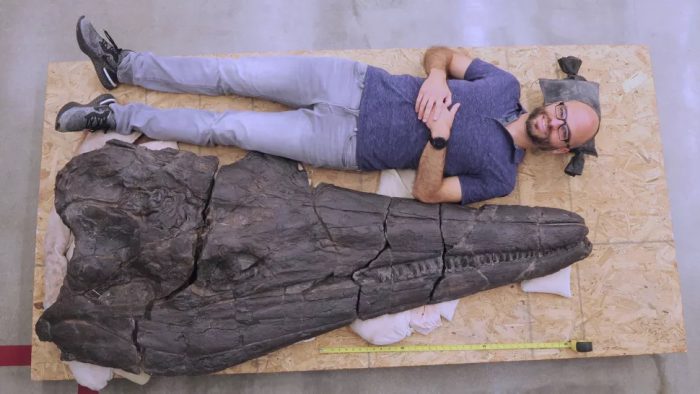Though they were in fact reptiles, one look at an ichthyosaur fossil and the comparisons to dolphins are hard to deny. With sleek bodies, air-breathing lungs, and long, narrow toothed snouts, these ancient marine predators share a lot with everyone's favourite chatty swimming mammals.
But as a new fossil found in Nevada helps to prove, though ichthyosaurs may have looked similar to dolphins, their size could be whale-like. Named Cymbospondylus youngorum, this huge reptile was about 17 metres (55 feet) long, which makes it about the size of a sperm whale. It may have even been the largest animal that the Earth had ever seen to that point.
And given the time it lived—247 million years ago during the early Triassic Period—this makes it a very interesting specimen. Let's see why.
Really big, really fast

A researcher lays down next to the massive skull of Cymbospondylus youngorum. (Martin Sander)
The Triassic Period began 252 million years ago. What came before that?, you may wonder. Only the worst extinction event in the history of Earth!
Known as the Great Dying (sounds cheery!), this is when continuous global volcanic eruptions caused about 90 percent of Earth's species to die out. Though life clearly recovered, it is remarkable to note how big certain creatures became so soon after such a terrible event.
True, in most cases five million years is a long time.
(Example: When will the next Zelda video game be coming out?
Sit tight, only five million years!
Well, that doesn't help me much!)
But in the world of evolution, five million years is not actually that long. For ichthyosaurs to go from being a brand new species on the planet to a beast the size of Cymbospondylus youngorum in that time is impressive. (And if we're really keeping score, it's more like three million years, since the first ichthyosaurs date back around 250 million years ago.)
By comparison, whales took many tens of millions of years to evolve to a similar size.
How did they do it?
Though the Earth after the Great Dying was low on biodiversity (different types of species), it was still full of creatures like ammonites, small fish, and squid. The perfect food for an ambitious, evolving new predator.
In addition, there would have been a relatively small amount of competition for this food. The stage was set for giant ichthyosaurs!
These beasts—whose dozens of species ranged from being dolphin to whale-sized—would go on to swim the seas for 150 million years. That's an amazing legacy, as well as proof of how life on Earth is able to rebound from even the most catastrophic global events.
 An artist's illustration of a newly discovered giant of the seas. (Stephanie Abramowicz / Natural History Museum of Los Angeles County)
An artist's illustration of a newly discovered giant of the seas. (Stephanie Abramowicz / Natural History Museum of Los Angeles County)









